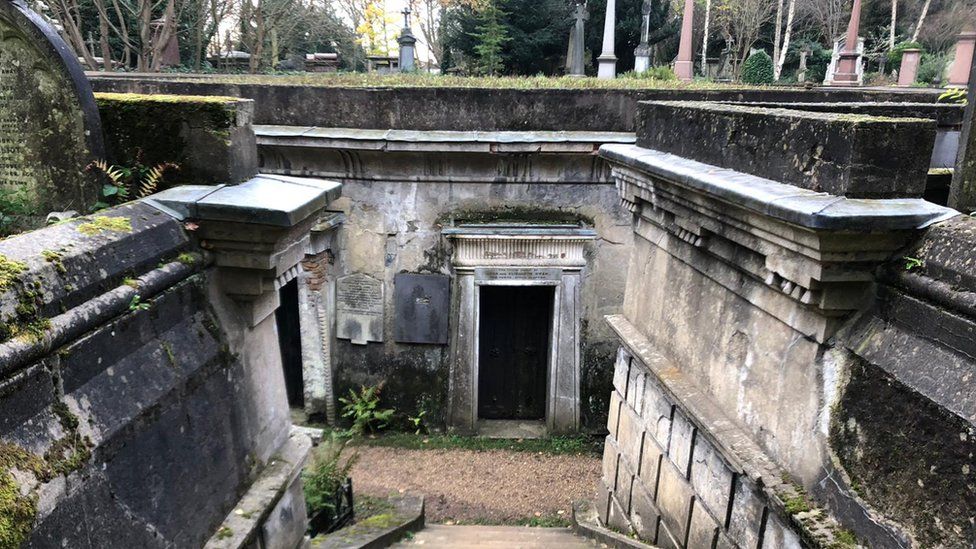Highgate Cemetery: Climate change risk to famous resting place
- Published
- comments

Highgate Cemetery is an entrancing place and well known for the famous - like Karl Marx and George Michael - who lie there.
But the romantic decay with which this site has become synonymous is now in danger of overtaking it.
Today, graves have been badly damaged by trees and debris.
April Cameron, a horticulturalist at the cemetery, says the trees are being hit hard by climate change.
Extreme heat, flooding and winds are making them much more susceptible to disease and therefore collapse onto the graves, she says.
"Partly it's the age of the tree but that combined with climate change has put them under stress," Ms Cameron added.
"We've had some very dry summers here and the ground conditions have been very dry for these trees and then we've had maybe torrential rain so that variation has caused problems with the trees and us. "
Future-proofing Highgate Cemetery against climate change
Faced with increasing problems and a growing maintenance bill, the Friends of Highgate Cemetery association has now decided to rethink the site.
It has just launched an architectural competition to gather ideas and designs for what the site should become over the next 25 years.
Whatever it is, the plan is for it to be resilient to a changing climate.
Dr Ian Dungavell, CEO Friends of Highgate Cemetery, said: "The trees will be better looked after and the right variety of trees planted in the right places and some of that will be for ecological reasons to create a different variety of habitat and some of it will be for aesthetic reasons."
Historic England said climate change is one of the most significant and fastest growing threats to people and their cultural heritage worldwide.
The problems vary from increased fungal and plant growth to increased insect infestations.
"Structural problems may also increase from changing extremes and fluctuations [heat as well as cold] in temperature," a spokesperson for Historic England added.
"In dry conditions soil shrinkage, particularly of those that are clay-rich, can lead to building subsidence, structural deformation and collapse in the most severe cases. Flooding is also a major problem."
Professor May Cassar, from the Institute for Sustainable Heritage at the University College London, said the capital has a particular problem in that many of its heritage buildings and sites are based on the banks of the Thames.
"When you think of London we're very lucky to have these world heritage sites," she said.
"You have the Palace of Westminster, which is currently undergoing restoration, we have the church of St Margaret's, Westminster Abbey, and then if we move east we have Tower of London and then we have the marvellous cluster of buildings at Greenwich.
"What all of these have in common is they are on the banks of the Thames. The Thames is a blessing to London but in climate change terms it can also be a threat. "
London currently has protection from rising sea levels and storm surges in the form of the Thames Barrier, she said.
"We are protected in the city of London to a very high standard by the Thames barrier but that was built in the 1970s. It should provide a very high standard of protection up until about 2030 - so we do have an unwelcome flood risk for the future."
Giving a warning to heritage sites, Professor Cassar said: "The evidence is there, we have to take it seriously and we would be irresponsible heritage guardians if we do not, and I don't know one heritage organisation that is not taking this seriously."
Preparing for the future, Highgate Cemetery is now undergoing a redesign which will take 25 years to complete.
Its staff believe there is little choice if they are to preserve one of London's most profound landmarks in the changing climate.
Related Topics
- Published15 October 2018
- Published5 February 2019